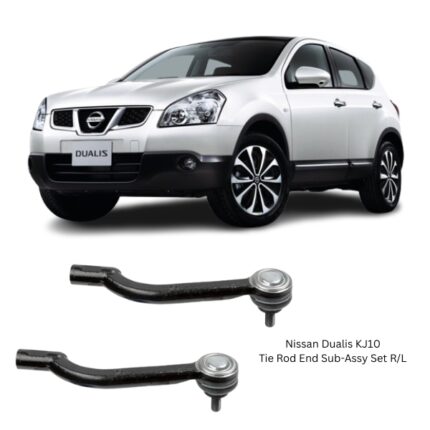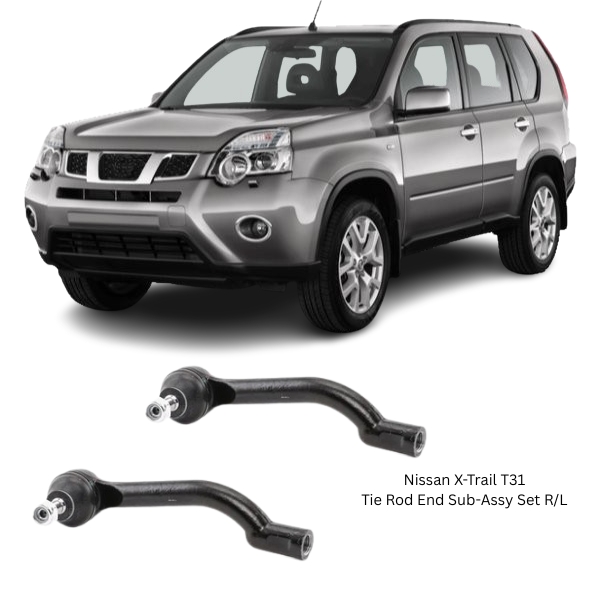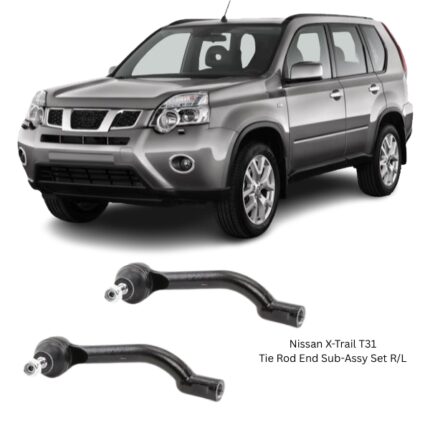Get Nissan X-Trail T31 Tie Rod End Sub-Assy Set R/L D8640-JG00A in Kenya
The Tie Rod End Sub-Assy Set (R/L) is an essential component in a vehicle’s steering system, providing the mechanical link between the steering rack (or center link) and the steering knuckle on both the right-hand and left-hand sides of the front suspension. This component set plays a pivotal role in determining the vehicle’s steering accuracy, stability, and overall road safety.
Comprising two matched assemblies—one for the right-hand (RH) and one for the left-hand (LH)—this set ensures that the steering system transmits motion smoothly and consistently to both front wheels, allowing the driver to maintain control and direction under various driving conditions.
Design and Construction
Each tie rod end sub-assembly is engineered for durability, strength, and precision. The design typically consists of:
1. Ball Stud
-
A hardened, spherical pin that swivels inside a socket.
-
It connects to the steering knuckle and pivots as the vehicle turns.
-
Forged from high-carbon or alloy steel for tensile strength and impact resistance.
2. Ball Socket Housing
-
Encases the ball stud, allowing multi-directional movement.
-
Designed with extremely tight tolerances to minimize play.
-
Typically treated with anti-corrosive coatings.
3. Threaded Shaft
-
Connects the outer tie rod to the inner tie rod or steering linkage.
-
Features threading that allows for toe angle adjustment during alignment.
-
Made from precision-machined, high-strength steel.
4. Dust Boot (Grease Seal)
-
A flexible rubber or thermoplastic elastomer boot.
-
Seals the ball joint and retains grease while keeping out contaminants.
-
Protects the internal components from moisture, dust, and road debris.
5. Locking Nut or Castle Nut with Cotter Pin
-
Used to fasten the tie rod end to the steering knuckle.
-
Locking features ensure secure installation and resistance to loosening from vibration.
Purpose and Function
The main function of the tie rod end sub-assembly is to transfer steering input from the steering gear or rack-and-pinion system to the wheel hub, allowing the wheels to turn as directed by the driver.
Primary Roles Include:
-
Transmission of Motion: Converts the linear motion from the steering rack into angular motion at the wheel.
-
Steering Control: Ensures the vehicle follows the intended path accurately.
-
Toe Adjustment: Enables precise alignment of the front wheels for optimal tire wear and handling.
-
Suspension Flexibility: Accommodates vertical and horizontal movements due to road irregularities and suspension travel.
Because of its critical role in directional control, the tie rod end must offer both flexibility and rigidity—a balance between free movement for steering and firm retention for alignment integrity.
Right-Hand (RH) vs Left-Hand (LH)
While both RH and LH tie rod ends serve the same function, they are handed to suit the design geometry of the vehicle’s suspension and steering systems.
-
RH (Right-Hand) Tie Rod End: Installed on the passenger side (in left-hand drive vehicles).
-
LH (Left-Hand) Tie Rod End: Installed on the driver’s side.
Differences may include:
-
Thread direction: Some systems use opposite threads to simplify toe adjustments.
-
Bending profile: Adjusted to accommodate chassis and component clearances.
-
Length and curvature: Tailored to fit suspension geometry.
It is essential to replace these parts with their correct side-specific versions to maintain the vehicle’s steering precision and wheel alignment.
Material and Manufacturing Standards
High-quality tie rod ends are manufactured under strict quality control processes. Material selection and manufacturing technology are geared toward maximum durability, strength, and corrosion resistance.
Materials:
-
Ball Stud: Heat-treated chromium or molybdenum alloy steel.
-
Housing: High-tensile steel with anti-rust coating.
-
Boot: High-quality synthetic rubber or thermoplastic elastomer (EPDM/TPE).
-
Grease: Lithium-based or molybdenum disulfide grease for long-lasting lubrication.
Manufacturing Processes:
-
Precision forging and CNC machining for consistency.
-
Induction hardening to improve wear resistance.
-
Salt spray testing to assess corrosion resistance.
-
Cycle and stress testing to ensure longevity.
Most reputable tie rod ends are ISO 9001 or IATF 16949 certified, meaning they meet automotive industry quality and safety standards.
Symptoms of a Worn Tie Rod End
Over time, tie rod ends can wear due to exposure to road elements, constant motion, and load stress. Recognizing signs of wear is crucial for maintaining steering performance and vehicle safety.
Common symptoms include:
-
Loose or Wandering Steering: Excessive play in the wheel, requiring constant corrections.
-
Clunking or Knocking Sounds: Especially when turning or driving over bumps.
-
Uneven or Accelerated Tire Wear: Usually due to misaligned toe settings.
-
Steering Wheel Vibration: Particularly at higher speeds.
-
Vehicle Pulling to One Side: Due to unequal steering input or component failure.
Timely replacement of worn tie rod ends helps avoid further suspension damage and dangerous driving conditions.
Inspection and Maintenance
Routine inspection during service intervals helps prevent tie rod failure:
-
Visual Inspection: Check for damaged dust boots or grease leakage.
-
Manual Testing: Check for excessive movement by rocking the wheel side to side.
-
Noise Check: Listen for creaks or knocks during steering.
-
Wheel Alignment: Misalignment may indicate wear or damage in the steering linkage.
Modern tie rod ends are mostly sealed units, requiring no regular greasing. However, those with grease fittings should be lubricated periodically with a compatible grease type.
Installation Guidelines
Proper installation is crucial to ensure correct steering function and wheel alignment. The process includes:
-
Removing the old tie rod end using a puller or separator tool.
-
Counting the turns during removal to approximate original alignment.
-
Installing the new tie rod end to the same depth or length.
-
Tightening to OEM torque specs with proper tools.
-
Installing new locking hardware (cotter pins or nuts).
-
Performing a full wheel alignment to restore proper geometry.
Improper installation or failure to realign can lead to poor handling and premature tire wear.
Performance and Safety Impact
A properly functioning tie rod end set ensures:
-
Stable Steering Feedback
-
Consistent Road Handling
-
Correct Tire Positioning
-
Reduced Mechanical Stress on other suspension components
Neglecting tie rod end maintenance can compromise steering precision and increase the risk of road accidents.
Follow us on Facebook for more parts.





Reviews
Clear filtersThere are no reviews yet.